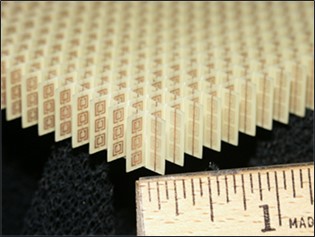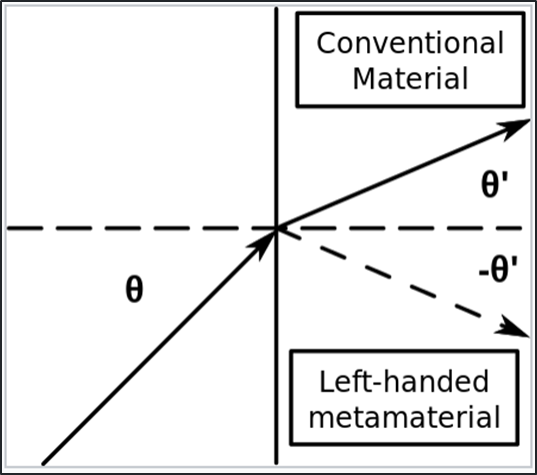Defense Systems Information Analysis Center (DSIAC) was asked if metamaterials (charged/active or otherwise) could be used to shield a friendly radar from electronic attack while simultaneously allowing that radar to continue to operate in that same band. DSIAC subject matter experts from Texas Research Institute and the Missouri University of Science and Technology provided initial answers to this question. Initial results show that some research is being conducted in the high-low terahertz range, and a few references indicate that research is being conducted in the lower-gigahertz range. Much of the published work is from China.
1.0 Introduction
The inquirer was interested in the use of metamaterials in a military application in which a radar could track a target with minimal or no susceptibility to in-band enemy radar jamming. Obviously, some level of frequency agility of the friendly radar is necessary to select a slightly different carrier than that of the attacker. However, could the use of metamaterials be a simpler and less expensive way to shield radar than the very agile radars employed by premier fighter aircraft today? The inquirer asked if there was research on employing a material activation timed with a pulse repetition interval similar to the way WWI machine guns were geared/timed to avoid shooting their own aircraft’s propeller.
In an alternate application, could friendly aircraft radar-warning receiver (RWR) antennas be selectively shielded while the host aircraft’s electronic protection jammer is operating on the target frequency? This shielding would be limited such that the RWR could still detect, e.g., the enemy surface-to-air missile, but would not itself be jammed by the friendly electronic countermeasure. Most aircraft employ physical distancing of electronic attack/electronic protection transmission antennas and RWR antennas, along with solid surface shielding to accomplish this effect today. Operators are forced to accept temporary system degradation while jamming. But could a metamaterial EMI filter be employed to allow for antenna proximity or for potentially using the same antenna without being subjected to friendly jamming?
This question was posed to the presenters of the Electromagnetic Interference (EMI) Shielding/Materials webinar presented by the Defense Systems Information Analysis Center on Thursday, 26 August 2021. The inquirer was initially asking about a shielding material that could operate similarly to a one-way valve. In other words, could it filter a frequency inbound, but allow it outbound?
2.0 Response
The ability to transmit electromagnetic (EM) waves through a medium without the waves entering back into the transmitter (a one-way filter) is an active research topic. The most likely solution to this problem is via the use of metamaterials.
A metamaterial is any material engineered to have a property that is not found in naturally occurring materials. It is made from assemblies of multiple elements fashioned from composite materials such as metals and plastics. The materials are usually arranged in repeating patterns, at scales that are smaller than the wavelengths of the phenomena they influence. A metamaterial such as that shown in Figure 1 derives its properties not from those of the base materials, but from its newly designed structure. Its precise shape, geometry, size, orientation, and arrangement give it its smart properties capable of manipulating EM waves (i.e., by blocking, absorbing, enhancing, or bending them) to achieve benefits beyond what are possible with conventional materials.


Figure 1: An Image of a Negative Index of Refraction Metamaterial Array Configuration, Which Was Constructed of Copper Split-Ring Resonators and Wires Mounted on Interlocking Sheets of Fiberglass Circuit Board (Source: Wikipedia.com). On the Bottom Is A Comparison of Refraction in a Left-Handed Metamaterial to That in a Normal Material (Source: Wikipedia.com).
Research into the use of metamaterials for radar shielding appears to be in the initial stages. A subject matter expert in the field of metamaterials, Dr. Kristen Donnell of the Missouri University of Science and Technology, stated that it is likely that metamaterials and/or frequency-selective surfaces could be used to provide a unidirectional response, but that little if any work has been published for the frequency ranges commonly used for radar. (See Table 1 for a discussion of the different frequency ranges available.) However, metamaterials are being used as unidirectional filters for much higher frequencies (approaching the terahertz [THz] range).
In 2017, Zang et al. [1] reported on broadband unidirectional behavior of EM waves via “transformation optics.” Li et al. [2] describe the use of a tunable, graphene-metal hybrid metamaterial for use as a unidirectional light transmitter (THz range; supported by the Government of China and the National Science Foundation). Another work (Yang and Lin [3]) discusses metamaterials for tunable, optical-frequency filtering (lower-THz or high-gigahertz [GHz] range, funded by the Government of China). Han et al. [4] discuss the use of a dual-band metamaterial to allow unidirectional, reflectionless propagation (funded by China and Korea). Yang et al. [5] reported one-way, helical EM wave propagation via a magnetized plasma within a microwave regime, although this plasma may not be considered a metamaterial.
Table 1: EM Radar Bands
| Band Name | Frequency Range | Wavelength Range | Notes |
|---|---|---|---|
| HF (High Frequency) | 3-30 MHz | 10-100 m | Coastal radar systems; over-the-horizon radars |
| VHF (Very High Frequency) | 30-300 MHz | 1-10 m | Very long-range, ground-penetrating; early radar systems generally operated in VHF as suitable electronics had already been developed for broadcast radio. Today this band is heavily congested and no longer suitable for radar due to interference. |
| P (Previous) | < 300 MHz | > 1 m | Applied retrospectively to early radar systems; essentially HF + VHF; often used for remote sensing because of good vegetation penetration. |
| UHF (Ultra-High Frequency) | 300-1000 MHz | 0.3-1 m | Very long range (e.g., ballistic missile early warning), ground penetrating, foliage penetrating; efficiently produced and received at very high energy levels; also reduce the effects of nuclear blackout, making them useful in the missile-detection role. |
| L (Long) | 1-2 GHz | 15-30 cm | Long-range air-traffic control and surveillance; widely used for long-range, early-warning radars as they combine good reception qualities with reasonable resolution. |
| S (Sentimetric) | 2-4 GHz | 7.5-15 cm | Moderate-range surveillance; terminal air-traffic control; long-range weather; marine radar; “sentimetric” was its code-name during WWII; less efficient than L, but offering higher resolution, making them especially suitable for long-range, ground-controlled interception tasks. |
| C (Compromise) | 4-8 GHz | 3.75-7.5 cm | Satellite transponders; a compromise (hence “C”) between X and S bands; weather; long-range tracking |
| X | 8-12 GHz | 2.5-3.75 cm | Missile guidance, marine radar, weather, medium-resolution mapping, and ground surveillance; in the United States, the narrow range (10.525 GHz ±25 MHz) is used for airport radar; short-range tracking; named “X” band because the frequency was a secret during WWII; diffraction off of raindrops during heavy rain limits the range in the detection role and makes this band suitable only for short-range roles or those that deliberately detect rain. |
| K (kurz) | 18-24 GHz | 1.11-1.67 cm | From German kurz, meaning “short”; limited use due to absorption by water vapor at 22 GHz, so Ku and Ka on either side used instead for surveillance; K-band is used by meteorologists for detecting clouds and by police for detecting speeding motorists; K-band radar guns operate at 24.150 ± 0.100 GHz. |
| Ku | 12-18 GHz | 1.67-2.5 cm | High-resolution, also used for satellite transponders; frequency under K band (hence “u”) |
| Ka | 24-40 GHz | 0.75-1.11 cm | Mapping, short range, airport surveillance; frequency just above K-band (hence “a”); photo radar; used to trigger cameras that take pictures of license plates of cars running red lights; operates at 34.300 ± 0.100 GHz. |
| mm | 40-300 GHz | 1.0-7.5 mm | Millimeter band, subdivided into the V, W, and higher bands (V and W shown below in this table); oxygen in the air is an extremely effective attenuator around 60 GHz, as are other molecules at other frequencies, leading to the so-called propagation window at 94 GHz. Even in this window, the attenuation is higher than that due to water at 22.2 GHz. This drawback makes these frequencies generally useful only for short-range, highly specific radars, like power-line avoidance systems for helicopters or use in space where attenuation is not a problem. Multiple letters are assigned to these bands by different groups. |
| V | 40-75 GHz | 4.0-7.5 mm | Very strongly absorbed by atmospheric oxygen, which resonates at 60 GHz. |
| W | 75-110 GHz | 2.7-4.0 mm | Used as a visual sensor for experimental, autonomous vehicles, high-resolution meteorological observation, and imaging. |
There may be research being conducted on millimeter-wave and higher-wavelength EM unidirectional transmission via the use of metamaterials, but this work is not being openly published. Up to this point, there has been no evidence that such an activity is impossible using metamaterials. Updates on applications of a unidirectional EM technology are currently unavailable from open sources owing to the vast majority of the work still being within the basic research regime.
References
[1] Zang, X., Y. Zhu, X. Ji, Q. Hu, and S. Zhuang. “Broadband Unidirectional Behavior of Electromagnetic Waves Based on Transformation Optics.” Scientific Reports, vol. 7, 2017.
[2] Li, C., L. Lui, J. Xu, and Z. Liu. “Tunable Unidirectional Light Transmission in a Graphene-Metal Hybrid Metamaterial.” Journal of Modern Optics, vol. 66, issue 10, 2019, pp. 1158−1162.
[3] Yang, W., and Y. Lin. “Tunable Metamaterial Filter for Optical Communication in the Terahertz Frequency Range.” Optics Express, vol. 28, no. 12, 2020.
[4] Han, G., R. Bai, X. Jin, Y. Zhang, C. An, and Y. Lee. “Dual-Band Unidirectional Reflectionless Propagation in Metamaterial Based on Two Circular-Hole Resonators.” Materials, vol. 11, 2018.
[5] Yang, B., M. Lawrence, W. Gao, Q. Guo, and S. Zhang. “One-way Helical Electromagnetic Wave Propagation Supported by Magnetized Plasma.” Scientific Reports, vol. 6, 2016.


